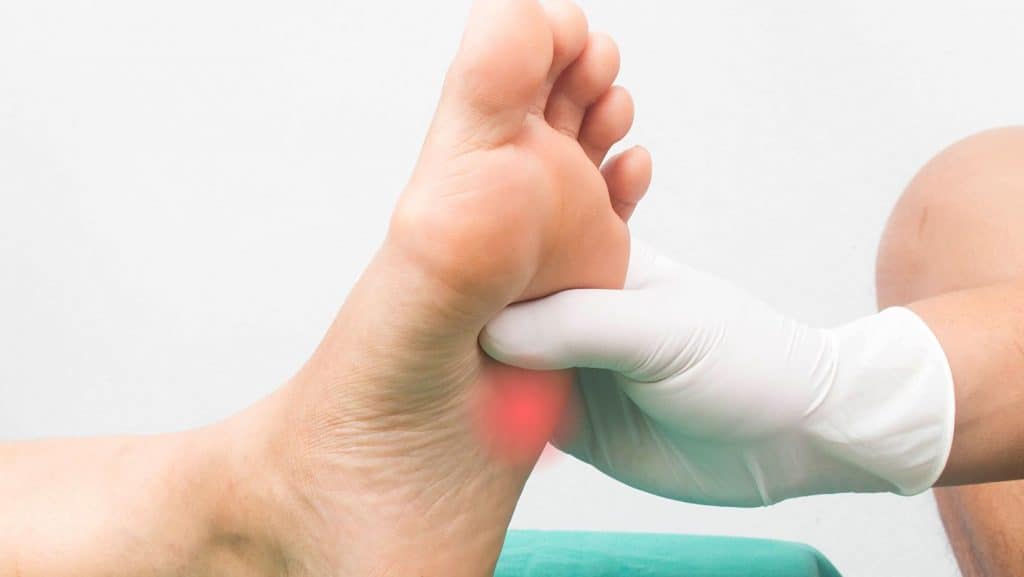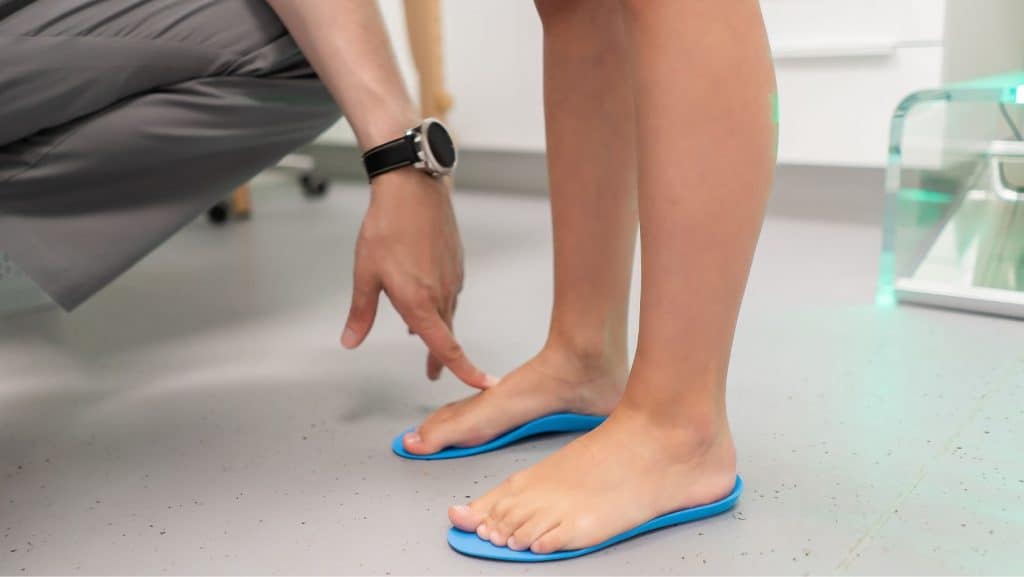Peroneal Tendon Tear
Read More >
Cuboid Syndrome is a generic term to describe pain on and around the cuboid bone. Cuboid Syndrome is not a diagnosis in itself; a thorough examination should be carried out to determine the exact cause of pain in the area. Throughout this article, we aim to explain the anatomy and causes of cuboid pain; we will detail the assessment of this pain and how to treat the potential causes of Cuboid region pain.
We will use the term Cuboid Syndrome throughout this article for cohesion.
The cuboid bone is a cube-shaped bone positioned on the foot’s lateral (outer) column; in most cases, the Cuboid bone has 6 bony articulations. These include the calcaneus posteriorly, the fourth and fifth metatarsals anteriorly, and the navicular and lateral cuneiform medially.
The function of the Cuboid bone varies from one individual to the next. Still, its primary movement is medial/lateral rotation about an anterior/posterior axis with the calcaneal process.
Surrounding the Cuboid bone are the Peroneal tendons, with the Peroneus Tertius attaching the dorsal (upper) and lateral (outer) aspect of the fifth metatarsal base. The Peroneus Brevis and Longus run parallel, with the Brevis attaching to the base of the fifth metatarsal. Most importantly, the Peroneus Longus wraps around the Cuboid bone before attaching to the lateral base of the first metatarsal and the medial cuneiform; we will discuss the vital role of the Peroneus Longus and Cuboid bone later in the article.

Cuboid syndrome is associated with pain on the outside of the foot. There may be some mild swelling around the cuboid bone or at the base of the fifth metatarsal, but this is not always the case, and there is rarely any visible bruising.
There may be tenderness to touch along the outer foot, and turning your foot outwards and inwards may be painful.
Walking, hopping, and jumping can cause pain outside the foot, and in irritable cases, there may be soreness with weight-bearing.
Cuboid syndrome can cause a reduced range of movement in the mid-foot, and we expect symptoms to ease with rest and in non-weight-bearing positions.
Patients may describe the sensation of the foot or ankle being ‘locked‘ or ‘stuck‘.
There are several potential causes of Cuboid syndrome or lateral foot pain.
The most common of these are lateral ankle sprains, particularly sprains that involve the midfoot being held in a fixed position while rapid inversion of the ankle occurs. We see this most often in windsurfing.
Lateral ankle sprains can overstretch the Peroneus Longus, causing a tear to the Peroneus Longus tendon as it wraps around the Cuboid bone.
Similarly, this mechanism of injury can lead to a Cuboid Pulley Lesion, where a lateral ankle sprain causes a pull of the Peroneus Longus Tendon on the Cuboid bone, leading to bone oedema (swelling) and tenosynovitis of the Peroneus Longus Tendon.
Other risk factors for cuboid syndrome include pes planus foot type, hypermobility, poorly fitted shoes or orthotics.
In a study of 3600 athletes, roughly 4% had symptoms originating from the Cuboid bone, while “cuboid syndrome” was diagnosed in 17% of professional ballet dancers.
If you have pain outside the foot, we always recommend a consultation with a Physical Therapist, Podiatrist or Sports Medicine Doctor. After a careful examination, it may be possible to establish a diagnosis.
Some clinical tests can be carried out to assess the cuboid area. Patients often report pain between the calcaneocuboid joint and the base of the fifth metatarsal. There may be tenderness along the Peroneus Longus, and resisted eversion can be painful.
Two clinical manoeuvres have been recommended midtarsal adduction test and the midtarsal supination test, but there is minimal evidence to support these clinical tests.
A clinician may refer a patient for an ultrasound or MRI scan to rule out other conditions, such as a Peroneus Longus Tear or Tenosynovitis, Os Peroneum, a cuboid fracture or bone bruising.

If you do not have access to a medical professional, we would recommend applying to POLICE principle to the management of suspected Cuboid Syndrome.
Treatment with a Physical Therapist or Podiatrist who specialises in foot conditions is recommended for Cuboid Syndrome.
Following an initial consultation, an examination of the foot and ankle should be carried out to assess the muscular and articular mobility of the foot with a particular focus on the midfoot.
Muscle function testing of the Peroneus Longus in a weight-bearing and non-weight-bearing position is important to assess for pain and the ability of the tendon to stabilise the first ray.
In our experience, a gait analysis is vital to assess for overloading of the lateral column of the foot. This analysis’s results can help guide a therapist on footwear selection and orthotics suggestions. Orthotics prescription for cuboid pain may involve a lateral forefoot wedge or a cuboid pad.
Manual therapy can be helpful for symptom relief, especially in cases where the patient is apprehensive about loading the lateral foot and it is affecting gait. Soft tissue massage to help relax and lengthen the calf and foot muscles. Mobilisations of the cuboid bone and surrounding bones may be combined with manipulation of the cuboid bone. However, this is not something we personally recommend.
Taping may be used to protect and offload the lateral foot; depending on the individual, a therapist may consider taping the subtalar joint into mild eversion to offload the Peroneal Tendons and lateral forefoot.
Stretches and strengthening exercises are likely to be prescribed to address foot and ankle muscular imbalances. We have spoken about the importance of strengthening the peroneal tendons in non-weight-bearing and weight-bearing positions on social media and provided some video exercises.

This is not medical advice. We recommend a consultation with a medical professional such as James McCormack. He offers Online Physiotherapy Appointments weekly.
Related Article: Cuboid Fractures: Symptoms & Diagnosis